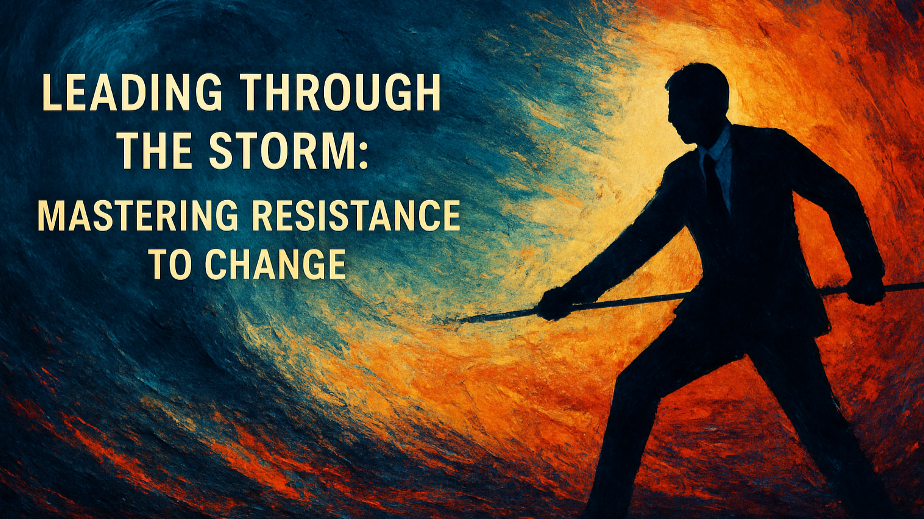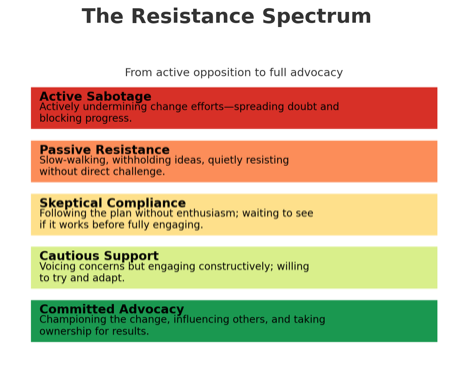Article
Leading Through the Storm: The New Playbook for Mastering Resistance to Change

Introduction: The Brutal Truth About Change
If you’re leading a company, here’s one brutal truth you can’t dodge: resistance to change isn’t just inevitable—it’s a gift. Most leaders don’t see it that way. They treat it like an obstacle to bulldoze, something to out-argue, out-maneuver, or silence. But resistance, if you know how to read it, is a living, breathing diagnostic tool.
Every objection, every sideways comment in a hallway, every moment of awkward silence in a meeting—it’s all data. It tells you where the trust gaps are, where the communication breakdowns have happened, and where your people’s unspoken fears live. If you ignore that data, you’re flying blind.
The hard numbers back this up: more than 70% of organizational change initiatives fail, not because the strategy was flawed, but because leaders underestimated what it would take to guide people through the emotional turbulence of transformation.
If you want your next big initiative to succeed, the shift starts here: stop seeing resistance as the enemy, and start listening to what it’s telling you. When you do, you’ll discover that resistance isn’t a wall to break down—it’s a map showing you exactly where to go next.
1. Rethink Resistance: It’s Data, Not Defiance
Let’s flip the lens. When people resist, they’re rarely doing it for sport. They’re sending up flares. They’re telling you something’s unclear, untested, or untrusted.
For example, I worked with a CEO rolling out a sweeping technology overhaul. His first instinct when his managers hesitated was frustration—until we sat down and dissected the resistance. It turned out the managers weren’t doubting the technology; they were worried about the gap between the training timeline and the rollout date. They didn’t fear change—they feared being set up to fail.
When you stop labeling resistance as “non-compliance” and start treating it like intelligence gathering, you find it points to the very levers you can pull to move the change forward.

The Resistance-to-Culture Connection
Here’s the thing: resistance isn’t random—it’s patterned. The form it takes can tell you a lot about your culture.
· When people go silent in meetings, it’s not neutrality—it’s often low trust or fear of retribution.
· Passive-aggressive compliance—nodding in agreement but quietly slow-walking the work—signals a lack of psychological safety.
· Public, heated pushback usually means you have a culture that tolerates candor but lacks alignment on purpose.
· Complaints about overload may point to a history of change fatigue from too many initiatives piled on at once.
· Cynical humor—the eye rolls, the sarcastic asides—often mask scars from past failures.
If you can read these signals, you’re no longer in the dark. You’re diagnosing in real time.
2. Get to the Root: Why People Really Resist
Surface objections are almost never the real story. Leaders who stop at “they’re afraid of change” miss the complexity. Resistance has layers—both emotional and systemic—and those layers interact.
Fear of the unknown is the big one. The human brain reacts to uncertainty like it reacts to physical danger. The amygdala, the brain’s threat detection system, lights up, flooding the body with stress chemicals that narrow focus and heighten defensiveness. You’re not just dealing with logic—you’re dealing with biology.
Loss of control is another potent trigger. When people feel changes are imposed without their input, it’s not just an operational issue—it’s a psychological one. That loss can feel like a stripping away of agency and status, especially in high performers.
Then there’s overload. Imagine already working at 110% and being told, “Oh, and here’s an entirely new system to learn—by Monday.” The mind doesn’t just resist; it shuts down.
Other drivers are more personal. Fear of failure makes people cling to the familiar because they don’t want to look incompetent. Self-interest comes into play when people sense a hit to their pay, position, or influence. And the ghosts of past change failures can haunt even the most promising new initiatives, breeding cynicism that says, “We’ve seen this movie before, and it doesn’t end well.”
Finally, there’s trust—or the lack of it. Sometimes the issue isn’t the change itself—it’s the leader pushing it.
3. The Anatomy of a Change Agent
Over decades of working with founders and executives, conducting thousands of 360 reviews and personality assessments, I’ve seen the same patterns emerge in leaders who make change real. They don’t just manage the process—they transform it.
They hold a vision with teeth—something concrete enough for people to imagine themselves in. They solve problems creatively, not just by tweaking the old ways but by challenging the underlying assumptions. They inspire authentically, showing up with visible commitment rather than relying on positional power.
They act decisively even when the data’s incomplete, and they follow through relentlessly. They know their strengths and weaknesses and stay open to feedback, which keeps their confidence grounded rather than inflated. And they build coalitions—not just at the top table, but across the informal networks where influence really lives.
The Two-Edged Sword of Strengths
Here’s the nuance: every one of these traits has a dark side. Independence of mind is invaluable—until it becomes stubborn isolation. Comfort with discomfort is a superpower—until it tips into recklessness. Bias for action moves things forward—until it causes leaders to leap before they’ve thought through the consequences. Even emotional steadiness can backfire if it becomes detachment.
The best change leaders aren’t just self-aware of their strengths—they’re alert to the moment those strengths start working against them.
4. Why Even Good Leaders Get Stuck
I’ve watched highly capable leaders stall out in change efforts because they hit invisible tripwires. Sometimes it’s fear—fear of being wrong, fear of losing allies, fear of stepping into the unknown.
Others get caught in the trap of popularity, avoiding necessary but unpopular decisions. Conflict aversion is another killer—dodging hard conversations allows tension to fester underground until it blows up.
Status quo bias is subtler but just as deadly, especially for leaders whose past successes were built on the very systems they now need to dismantle. Add impostor fears and burnout to the mix, and even the most visionary leader can retreat into caution.
And when the ghosts of past failures start whispering, cynicism takes over—not just in teams, but in leaders themselves.
5. The Leadership Edge: Transformational Over Transactional
Managers maintain. Leaders transform. The difference isn’t about being inspiring in an abstract way—it’s about doing the work to engage people fully in the journey.
That starts with building and broadcasting a vision people can feel in their bones. Not a polished slide deck, but a story that connects the change to something urgent, personal, and worth caring about.
It means making communication a living, two-way conversation, not a one-time announcement. It’s about engaging people early, letting them shape the how, so the plan becomes theirs. It’s about resourcing them so thoroughly they can’t say they were set up to fail.
And it’s about showing up yourself—visibly, consistently, in the hard moments—because if you’re not walking the talk, no one else will either.
Adaptive Storytelling
Your story about the change isn’t static—it has chapters. In the early stage, it’s about vision and urgency: “Here’s why we must act now.” In the middle, it’s about momentum: “Here’s what we’ve achieved together.” And in the later stage, it’s about identity: “This is who we are now.” Leaders who master these narrative shifts keep their teams connected from start to finish.
6. Avoiding the Sabotage Traps
I’ve seen too many change efforts die for predictable reasons: ignoring the human element, letting communication gaps breed rumors, staying rigid when feedback screams for adjustment, or failing to acknowledge the scars of the past.
Victor—a division head I coached—learned this the hard way. His unwillingness to adapt, to listen to younger and more diverse perspectives, turned his once-valuable experience into a liability. The result? A demoralized team and a failed initiative.
7. From Compliance to Commitment
Real change can’t be forced into existence through memos or mandates. The leaders who pull their teams through the storm don’t just run projects—they build movements. They create clarity when the air is thick with uncertainty. They anchor their people in trust when fear is the easy default. They make empathy as important as execution.
When you do that, resistance stops being a wall—and starts becoming the scaffolding you build the future on.
share this
Related Articles
Related Articles





